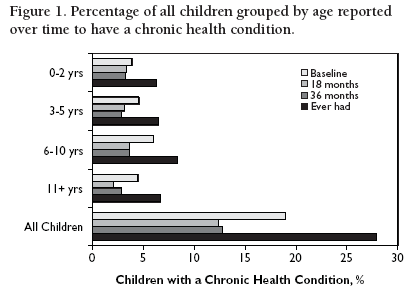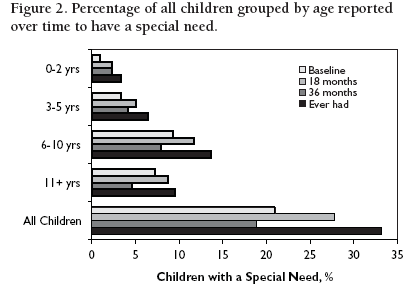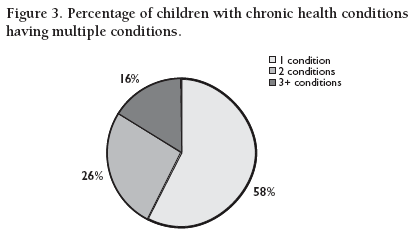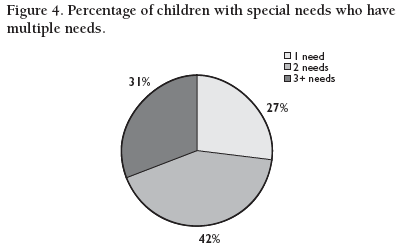Return to Previous page |
| PDF Version, B&W |
National Survey of Child and Adolescent Well-Being
No. 7: Special Health Care Needs Among Children in Child Welfare
Research Brief
Findings from the NSCAW Study
Children living with special health care needs often require extensive health and related social services. These needs further present social, emotional, and economic challenges to children and their families. If left unaddressed, they also carry with them the potential for ongoing negative developmental consequences. Although there is information showing high rates of chronic health conditions and special needs among children involved in foster care,1-3 this knowledge is limited and often does not address the full array of problems that may exist among children involved in the broader child welfare system.
This research brief examines the presence of special health care needs among children in the child welfare system (CWS). It specifically examines the presence of chronic health conditions (e.g., asthma, diabetes) and special needs (e.g., emotional disturbance, speech impairment, developmental delay). It provides information about the rates of these health conditions and special needs over the course of a 3-year period. It asks the following questions:
-
What percentages of children involved in the child welfare system have chronic health conditions and/or special needs?
-
Do the rates of these conditions and needs differ by a child’s gender, race/ethnicity, or age?
-
Are the rates of these conditions and needs related to a child’s CWS placement or adoption history? Are the rates related to the type of reported maltreatment?
What Does It Mean for Children to Have Special Health Care Needs?
Since 1998, the federal Maternal and Child Health Bureau (MCHB) has used the term “special health care needs” (SHCN) to identify those children “who have or are at increased risk for a chronic physical, developmental, behavioral, or emotional condition and who also require health and related services of a type or amount beyond that required by children generally.”4 “Risk” by this definition includes both biological (e.g., low birth weight) and environmental (e.g., child abuse or neglect) factors. Furthermore, “health and related services” includes traditional medical services (e.g., pediatric or mental health care) as well as therapeutic services (e.g., speech, occupational therapy), family support services, early intervention, and/or special education services. By this definition, it is estimated that approximately 12.8% of children in the U.S. population have an SHCN.5
Previous research suggests that children involved in CWS, particularly those in foster care, are at greater risk for certain types of SHCNs than children in the general population. Thirty to 60 percent of children in foster care have been estimated to have chronic health conditions.2, 6 When behavioral, emotional, and developmental concerns are taken into consideration, the estimated proportion of foster children with serious health care needs jumps to over 80%.1-3 Children reported for maltreatment, regardless of whether or not this maltreatment is substantiated, also show greater rates of developmental and behavioral problems than children in the general U.S. population.7, 8
There are still many unanswered questions. The majority of studies regarding the SHCNs of children in child welfare focus exclusively on children in foster care or are not derived from nationally representative samples. Furthermore, studies of SHCN children in child welfare have most typically focused on individual conditions (e.g., developmental delays, mental health problems). So, while children who come to the attention of CWS for reports of maltreatment may show elevated rates of SHCN, there has been no comprehensive, national examination of physical, developmental, behavioral, and emotional SHCNs among children within CWS.
This Brief Examines Data from a National Sample of Cases Involving Allegations of Maltreatment
In this research brief, data from the National Survey of Child and Adolescent Well-Being (NSCAW) is used to describe SHCNs of children in the CWS. NSCAW is a national longitudinal study of the well-being of more than 5,500 children ages 14 and younger who were involved in child maltreatment investigations by CWS in 1999 and 2000.9 Data from NSCAW cannot be directly translated to fit the Maternal and Child Health Bureau’s definition of child SHCNs. For instance, NSCAW does not provide information about problem severity or estimates of the extent of services needed or utilized over time for given problems. NSCAW does, however, allow the examination of specific chronic health conditions and special needs by problem type and according to caregiver report.
The data presented are drawn from caregiver and caseworker interviews at baseline (two to six months after the close of a CWS investigation) and at 18- and 36-month follow-ups for all children in the NSCAW Child Protective Services sample. Caseworker reports of a child’s maltreatment and CWS placement history are used to determine the relationship between these factors and SHCNs. Caregiver reports of child chronic health conditions and special needs across three points in time will be used to approximate the proportion of SHCNs among children in the child welfare population. Due to the NSCAW survey structure, it is important to consider the rates of SHCNs across the baseline, 18-month, and 36-month interviews. Following baseline, caregivers were only asked about the identification of special needs since the last interview period. Information gathered across these three time points is used here to portray a comprehensive picture of both chronic health conditions and special needs among children in CWS.
About the children in the sample
The average age of children assessed or investigated by CWS after reports of child abuse or neglect was 7 years. Among these children, the largest group were younger than 5 years of age (50%) at baseline and the next largest group were older than 10 years (21%). The children were evenly divided between males and females. White children made up the largest group (47%), followed by African-American (28%) and Hispanic (18%) children. Forty-six percent of children primarily came to the attention of CWS from a report of neglect; 27% had experienced physical abuse as the most serious form of recorded maltreatment. Through the 36-month follow-up, 39% were placed outside of their biological home at least once and 9% were reported to have been adopted.
Caregivers Identify Children’s Chronic Health Conditions and Special Needs
For the purposes of this research brief, the identifi cation of both chronic health conditions and special needs is based upon caregiver (biological, kin, foster, or adoptive) report. In NSCAW, caregivers are asked about whether their child has any health problems that last a long time or come back again and again. They are then asked to identify any chronic health conditions their child has. Caregivers are also asked if they have been told by an education or health professional that their child has “learning problems, special needs, or developmental disabilities,” and they are asked to name the problems. Table 1 lists all those conditions used, when reported by caregivers, to identify the presence of either a chronic health condition or a special need. This research brief presents findings separately for chronic health conditions and for special needs, as well as a summary of these needs together to approximate the prevalence of SHCNs.
Children with chronic health conditions
During the 3 years following CWS investigation for maltreatment, 28% of children were reported by caregivers as having a chronic health condition. At any given time, between 13% and 19% of children were reported to have such a condition. The most commonly reported condition was asthma (13% of all children over the course of 3 years10). Other conditions less frequently reported over the course of 3 years included repeated ear infections (5%), other respiratory problems (5%), severe allergies (5%), epilepsy (2%), and eczema or other skin disease (2%). There were no differences in the report of these chronic health conditions by child gender or race/ ethnicity.
Figure 1 shows the percentage of children across different age groups reported by their caregiver as having a chronic health condition at baseline, at the 18- and 36-month follow-ups, and ever having been reported to have a chronic health condition at any of these points in time. Rates of chronic health conditions appear to be relatively stable over time and are similar across age groups.
Children with special needs
During the 3 years after a CWS investigation for alleged maltreatment, 33% of children were reported by caregivers as having had a learning problem, special need, or developmental disability. At any
given time, between 19% and 28% of children were reported to have such a need. Most commonly, children were reported as having a learning disability (21% of the total sample), emotional disturbance (14%), or speech impairment (12%). Although less commonly reported, a noteworthy proportion of children were reported to have mental retardation (2%), hearing impairment (2%), vision impairment (1%), or autism (1%). There were no differences in the report of these special needs by a child’s race or ethnicity. As in the general child population, reports of special needs did differ by gender. Boys (19.8%) were significantly more likely than girls (13.3%) to be reported over the study period as having a special need.
Table 1. Chronic Health Conditions and Special Needs
| Chronic Health Conditions | Special Needs |
|---|---|
| AIDS Anemia Arthritis/joint problems Asthma Brain tumor Cerebral palsy Chronic heart condition Diabetes Eczema/other skin disease Epilepsy/fits/convulsions Fetal alcohol syndrome Hernia High blood pressure Other birth defect, (e.g., cleft palate) Other blood disorder Other respiratory problems Persistent bowel problems Physical deformities Repeated ear infections Severe allergies Sickle cell anemia Spina bifida |
Autism Deafness Emotional disturbance/ behavioral disorder Hearing impairment Mental retardation Multiple disabilities Orthopedic impairment Specific learning disability Speech or language impairment Traumatic brain injury Visual impairment, including blindness |
Figure 2 shows the percentage of children across different age groups reported by their caregiver as having a special need at baseline, at the 18- and 36-month follow-ups, and ever reported to have had a special need at any of these time points. The rate of identified special needs increases as a child ages. A higher rate of special needs among school-aged youth is in part due to the definition of this term. Caregivers are specifically asked if an “educational” or other professional has identified such a need in their child. So, as would be expected, older children (6–14 years at baseline) are more likely to be identified as having a special need than younger children (0–5 years at baseline).
Children with Multiple Chronic Health Conditions or Special Needs
Over the course of the 3-year follow-up period, children frequently experienced more than one chronic health condition or special need. This was particularly true for children with special needs. While it should be noted that children may not have experienced all of these conditions at once, the proportion of children who experienced multiple condition types over time is still remarkably high.

[D]
|

[D] |
Figure 3 shows the percentage of children reported to have ever had a chronic health condition and those who experienced multiple conditions. While over half of the children were reported to have only had one, sizeable proportions experienced multiple conditions. Among those reported to have had a special need, multiple needs were the norm (see Figure 4). In fact, 31% were reported to have had three or more special needs identified over the course of 3 years.

[D] |

[D] |
Children with Special Health Care Needs
Caregivers reported that half of the children had at least one of the chronic health conditions or special needs listed in Table 1 at some point over the three-year study period. At baseline, 35% of children were reported to have had either a chronic health problem or special need. Thirty-six percent were reported to have such a condition or special need at the 18-month follow-up, and 28% had such a condition or need 36 months following the baseline incident of alleged maltreatment.
Placement History Is Associated with Chronic Health Conditions and Special Needs
Out-of-home placement and adoption history were associated with higher rates of chronic health conditions and special needs. Children who had been placed out of home at least once during the 3-year study period (32%) were significantly more likely to be reported as having ever had a chronic health condition than those without such a placement history (27%); they were also slightly more likely (38%) than those who remained at home (32%) to have ever had a special need. Children adopted at some point during the study period were significantly more likely (49%) to have a special need than those who had never been adopted (33%). Adoption history was not associated with the rate of reported chronic health conditions.
The type of alleged maltreatment (physical maltreatment, sexual abuse, neglect, or multiple types of maltreatment experienced) at baseline showed little relationship to a child’s ever having had a chronic health condition or a special need.
Key Findings
-
Children in the CWS show rates of chronic health conditions, particularly asthma, that are relatively comparable to national estimates for all U.S. children. However, children with a history of out-of-home placement have higher rates of chronic health conditions than are described for children across the country.
-
Children in the CWS show higher rates of special needs than children in the typical U.S. population. An especially high proportion of children with a history of out-of-home placement were identified as having special needs. About half of adopted children were identified over a 3-year period as having a special need.
-
Having a history of multiple problems is the norm for children in the child welfare system with reported histories of chronic health conditions or special needs. Forty-two percent of children with a chronic health condition were reported to have had two or more chronic health conditions over the course of 3 years. Among those reported to have ever had a special need, 73% were reported to have had two or more special needs over the 3-year period.
- Half of the children coming to the attention of CWS for maltreatment were reported over the course of 3 years to have a chronic health condition or a special need or both.
What Does This Mean?
Twenty-eight percent of children had a chronic health condition during the 3 years following CWS investigation for maltreatment. It is not possible to make a straightforward comparison of this overall proportion to children in the general population because national estimates of chronic physical health conditions vary in the degree that their definitions encompass physical, developmental, and/or behavioral needs. Consequently, national comparisons of chronic physical health problems are more easily made by looking at specific conditions. Among children in child welfare, the most commonly reported chronic health condition was asthma (13%). This finding is consistent with national studies that show asthma as the most common illness among U.S. children. A recent national study estimated that 12% of all children (under the age of 18) had at some point in their lives suffered from asthma.11 So, children coming to the attention of CWS do not show higher rates of the most common childhood illness, asthma, than U.S. children. While it is beyond the scope of this research brief to examine service utilization, a critical issue for the child welfare system is ensuring that children with chronic health conditions have such needs addressed by the relevant health service systems.
Children in the CWS show higher rates of special needs than children within the general U.S. population. The problems identified here as “special needs” are those considered relevant for special education evaluation or service referral. Thirty-three percent of children were reported by caregivers to have ever had a special need during the 3 years after a CWS investigation for alleged maltreatment. At any given time, between 19% and 28% of all children were reported to have such a need. Among children 6 years and older at baseline, the rates of special needs reported across waves ranged from 13-20%. The rates of special needs observed are substantially higher than the 12% of all U.S. students (6 to 21 years) who received special education services in 2005.12 Most commonly, children in the CWS were reported over the course of 3 years to have a learning disability (22%), emotional disturbance (15%), or speech impairment (13%). At the national level, it is estimated that 8% of children have ever had a learning disability.13 It has also been estimated that, at any given point in time, approximately 6% of U.S. children have needs consistent with a serious emotional disturbance,14 while 5% to 9% have speech/language impairments.15 In each case, these estimates are lower than those found here for children investigated for maltreatment.
Previous studies have found high rates of SHCNs among children involved placed in out-of-home care.1-3 Findings from this research brief support findings that children with a history of out-of-home placement are at particular risk for both chronic health problems and special needs. Children in out-of-home care could be at increased risk due to a greater prevalence of biological and/or environmental risk factors. It might also be the case that children in out-of-home care are more likely to have their needs identified and/or reported. While it is outside of the scope of this research brief to examine these links between out-of-home placement and SHCNs, it is an important area for future investigation.
Clearly, many children who come in contact with the CWS are at risk for the development of both chronic health conditions and special needs. They are also likely to have several such conditions and/or needs at the same time. Such multiple needs require cross-service-system collaboration in order to best support these children and their biological, foster, or adoptive families. This is in keeping with the framework of the 2003 Child Abuse and Prevention Treatment Act, which describes the problem of child abuse and neglect as one requiring the integration of “social service, legal, health, mental health, education, and substance abuse agencies.” More specifically, these findings also support decisions on the part of groups such as the American Academy of Pediatrics that call for comprehensive health screening procedures to be a routine part of social services plans, particularly for children in out-of-home placements.15 Children in the child welfare system have needs and problems requiring attention across a variety of human service sectors. These needs clearly stretch beyond the sole responsibility of CWS.
1 Halfon, N., Mendonca, A., & Berkowitz, G. (1995). Health status of children in foster care. Archives of Pediatric and Adolescent Medicine, 149, 386-392.
2 Jee, S.H., Barth, R.P., Szilagzyi, M.A., Szilagyi, P.G., Aida, M., & Davis, M.M. (2006). Factors associated with chronic conditions among children in foster care. Journal of Health Care for the Poor and Underserved, 17, 328-341.
3 Leslie, L.K., Gordon, J.N., Meneken, L., Premji, K., Michelmore, K.L., & Ganger, W. (2005). The physical, developmental and mental health needs of young children in child welfare by initial placement type. Journal of Developmental and Behavioral Pediatrics,
26, 177-179.
4 McPherson, M., Arango, P., Fox, H., Lauver, C., McManus, M., Newacheck, P.W., Perrin, J.M., Shonkoff, J.P., & Strickland, B. (1998). A new definition of children with special health care needs. Pediatrics, 102, 137-139.
5 VanDyck, P.C., Kogan, M.D., McPherson, M.G., Weissman, G.R., & Newacheck, P.W. (2004). Prevalence and characteristics of children with special health care needs. Archives of Pediatric and Adolescent Medicine, 158, 884-890.
6 Takayama, J.I., Wolfe, E., & Coulter, K.P. (1998). Relationship between reason for placement and medical findings among children in foster care. Pediatrics, 101, 201-207.
7 Stahmer, A.C., Leslie, L.K., Hurlburt, M., Barth, R.P., Webb, M.B., Landsverk, J., & Zhang, J. (2005). Developmental and behavioral need and service use for young children in child welfare. Pediatrics, 116, 891-900.
8 Burns, B.J., Phillips, S.D., Wagner, H.R., Barth, R.P., Kolko, D.J., Campbell, Y., & Landsverk, J. (2004). Mental health need and access to mental health services by youth involved with child welfare: A national survey. Journal of the American Academy of Child and Adolescent Psychiatry, 43, 960-970.
9 For more information on NSCAW methodology, see NSCAW Research Group (2002). Methodological Lessons from The National Survey of Child and Adolescent Well-Being: The First Three Years of the USA’s First National Probability Sample of Children and Families Investigated for Abuse and Neglect.
Children and Youth Services Review, 24, 513-543; and U.S. Department of Health and Human Services, Administration for Children and Families (2005). National Survey of Child and Adolescent Well-Being (NSCAW): CPS Sample Component, Wave 1 Data Analysis Report. Washington, DC: ACF.
10 Condition-specific percentages (e.g., asthma, emotional disturbance) cited in this report represent the percentage of all children within NSCAW reported to have such a condition over the course of 3 years. Percentages do not represent the percentage of children with chronic health conditions or special needs who have a certain condition.
11 Bloom, B., & Dey, A.N. (2006). Summary health statistics for U.S. children: National Health Interview Survey, 2004, Vital and Health Statistics (Vol. 10, pp. 1-94): National Center for Health Statistics.
12 U.S. Department of Education. (2005). 25th Annual (2003) Report to Congress on the Implementation of the Individuals with Disabilities Act (Vol. 1): U.S. Department of Education.
13 Costello, J.E., Messer, S.C., Bird, H.R., Cohen, P., & Reinherz, H.Z. (1998). The prevalence of serious emotional disturbance: A re-analysis of community studies. Journal of Child and Family Studies, 7(4), 411-432.
14 ASHA. (2007). Speech-Language Disorders and the Speech-Language Pathologist Available: http://www.asha.org/students/professions/overview/sld.htm.
15 AAP Committee on Early Childhood, A., and Dependent Care,. (2002). Health care of young children in foster care. Pediatrics, 109 (3), 536-541.
National Survey of Child and Adolescent Well-Being Research Brief Administration for Children and Families (ACF, OPRE) http://www.acf.hhs.gov/programs/opre/abuse_neglect/nscaw/ This is the seventh in a series of NSCAW research briefs focused on children who have come in contact with the Child Welfare System. Additional research briefs focus on the characteristics of children in foster care, the provision of services to children and their families, and the maltreatment investigation substantiation process. |
| Return to Previous page |



